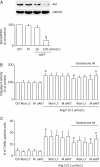Tanshinone IIA attenuates angiotensin II-induced apoptosis via Akt pathway in neonatal rat cardiomyocytes
- PMID: 21102479
- PMCID: PMC4002950
- DOI: 10.1038/aps.2010.176
Tanshinone IIA attenuates angiotensin II-induced apoptosis via Akt pathway in neonatal rat cardiomyocytes
Abstract
Aim: to examine the effects of tanshinone IIA, the main effective component of Salvia miltiorrhiza (known as 'Danshen' in traditional Chinese medicine) on angiotensin II (Ang II)-mediated cardiomyocyte apoptosis.
Methods: rat neonatal cardiomyocytes were primarily cultured with Ang II or Ang II plus tanshinone IIA. Myocyte apoptosis was evaluated by caspase-3 activity and DNA strand break level with TdT-mediated dUTP nick-end labeling (TUNEL) staining. Western blot analysis was employed to determine the related protein expression and flow cytometry assay was used to determine the TUNEL positive cells and the intracellular reactive oxygen species (ROS) production. SiRNA targeted to Akt was used.
Results: ang II (0.1 micromol/L) remarkably increased caspase-3 activity, TUNEL positive cells, and cleaved caspase-3 and cytochrome c expression, but reduced Bcl-X(L) expression. These effects were effectively antagonized by pretreatment with tanshione IIA (1-3 micromol/L). Tanshinone IIA had no effect on basal ROS level, while attenuated the ROS production by Ang II. Interestingly, tanshione IIA significantly increased the phosphorylated Akt level, which was countered by the PI3K antagonist wortmannin or LY294002. Knockdown of Akt with Akt siRNA significantly reduced Akt protein levels and tanshinone IIA protective effect.
Conclusion: tanshinone IIA prevents Ang II-induced apoptosis, thereby suggesting that tanshinone IIA may be used for the prevention of the cardiac remodeling process.
Figures





Similar articles
-
Tanshinone IIA prevents doxorubicin-induced cardiomyocyte apoptosis through Akt-dependent pathway.Int J Cardiol. 2012 May 31;157(2):174-9. doi: 10.1016/j.ijcard.2010.12.012. Epub 2010 Dec 28. Int J Cardiol. 2012. PMID: 21190747
-
Tanshinone IIA protects neonatal rat cardiomyocytes from adriamycin-induced apoptosis.Transl Res. 2008 Feb;151(2):79-87. doi: 10.1016/j.trsl.2007.11.005. Epub 2007 Dec 28. Transl Res. 2008. PMID: 18201675
-
Tanshinone IIA Prevents Leu27IGF-II-Induced Cardiomyocyte Hypertrophy Mediated by Estrogen Receptor and Subsequent Akt Activation.Am J Chin Med. 2015;43(8):1567-91. doi: 10.1142/S0192415X15500895. Epub 2015 Nov 30. Am J Chin Med. 2015. PMID: 26621443
-
Tanshinone IIA: New Perspective on the Anti-Tumor Mechanism of A Traditional Natural Medicine.Am J Chin Med. 2022;50(1):209-239. doi: 10.1142/S0192415X22500070. Epub 2022 Jan 4. Am J Chin Med. 2022. PMID: 34983327 Review.
-
Tanshinone IIA: Pharmacology, Total Synthesis, and Progress in Structure-modifications.Curr Med Chem. 2022;29(11):1959-1989. doi: 10.2174/0929867328666211108110025. Curr Med Chem. 2022. PMID: 34749607 Review.
Cited by
-
Tanshinone IIA inhibits hypoxia-induced pulmonary artery smooth muscle cell proliferation via Akt/Skp2/p27-associated pathway.PLoS One. 2013;8(2):e56774. doi: 10.1371/journal.pone.0056774. Epub 2013 Feb 21. PLoS One. 2013. PMID: 23437233 Free PMC article.
-
Interactions of a medicinal climber Tinospora cordifolia with supportive interspecific plants trigger the modulation in its secondary metabolic profiles.Sci Rep. 2019 Oct 4;9(1):14327. doi: 10.1038/s41598-019-50801-0. Sci Rep. 2019. PMID: 31586109 Free PMC article.
-
Tanshinone IIA therapeutically reduces LPS-induced acute lung injury by inhibiting inflammation and apoptosis in mice.Acta Pharmacol Sin. 2015 Feb;36(2):179-87. doi: 10.1038/aps.2014.112. Epub 2014 Dec 29. Acta Pharmacol Sin. 2015. PMID: 25544360 Free PMC article.
-
Jia-Shen decoction-medicated serum inhibits angiotensin-II induced cardiac fibroblast proliferation via the TGF-β1/Smad signaling pathway.Mol Med Rep. 2016 Aug;14(2):1610-6. doi: 10.3892/mmr.2016.5405. Epub 2016 Jun 16. Mol Med Rep. 2016. PMID: 27315199 Free PMC article.
-
The complex regulation of tanshinone IIA in rats with hypertension-induced left ventricular hypertrophy.PLoS One. 2014 Mar 19;9(3):e92216. doi: 10.1371/journal.pone.0092216. eCollection 2014. PLoS One. 2014. Retraction in: PLoS One. 2024 Mar 12;19(3):e0300689. doi: 10.1371/journal.pone.0300689. PMID: 24647357 Free PMC article. Retracted.
References
-
- Masri C, Chandrashekhar Y. Apoptosis: a potentially reversible, meta-stable state of the heart. Heart Fail Rev. 2008;13:175–9. - PubMed
-
- Sorescu D, Griendling KK. Reactive oxygen species, mitochondria, and NAD(P)H oxidases in the development and progression of heart failure. Congest Heart Fail. 2002;8:132–40. - PubMed
-
- Paul M, Poyan Mehr A, Kreutz R. Physiology of local renin-angiotensin systems. Physiol Rev. 2006;86:747–803. - PubMed
-
- Schroder D, Heger J, Piper HM, Euler G. Angiotensin II stimulates apoptosis via TGF-beta1 signaling in ventricular cardiomyocytes of rat. J Mol Med. 2006;84:975–83. - PubMed
Publication types
MeSH terms
Substances
LinkOut - more resources
Full Text Sources
Medical
Research Materials
Miscellaneous

